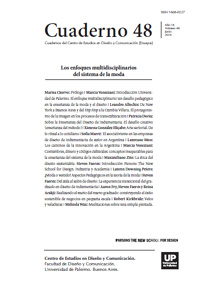Arte Sartorial. De lo ritual a lo cotidiano
Abstract
Much has been said about dress origins: it has served to distinguish roles within a group or a community and it has been used as a protection for exposure or nudity.
However, we must not forget its importance in terms of spiritual protection. The suit was
also a communication channel with other realities, other scopes and dimensions, able to
transform and transport its user. It has been a refuge, shield and fetish, second skin, habitat.
As in the sacred space of shamanic religions, or in the performing arts, clothing and mask
play an important role in which the object is no longer a garment to become an element
that harmonizes with the body and transmutes materiality in another entity that acquires
the attributes represented by the suit. This article approaches the parallels between art and
fashion and discusses some works of artists which from the genre of performance, embody
change phenomenon with simultaneously poetic and magical relationships.
References
San Pablo: Catalogue Raisonné.
Prinz, U. (2004) No do couro da onça. Reflexiones sobre la transformación y la metamorfosis en las tierras bajas de Sudamérica. En: Boletín de Antropología.18 - 35, pp. 283-298. Medellín: Universidad de Antioquia.
Saltzman, A. (2004) El cuerpo diseñado. Sobre la forma en el proyecto de la vestimenta. Bue- nos Aires: Paidós Sustaita Aranda, J.A. (2011). La función de la palabra en la reconstrucción del cuerpo huma- no en el arte contemporáneo.Tesis doctoral. ISBN 978-84-695-0333-1. Madrid: Universidad Complutense de Madrid, Facultad de Bellas Artes.
Vásquez Rocca, A. (11-2005). La moda en la postmodernidad. Deconstrucción del fenó- meno fashion. Nómadas Revista Crítica de Ciencias Sociales y Jurídicas. ISSN 1578-6730. Madrid: Universidad Complutense de Madrid.
Viveiros de Castro, E. (10, 1998). Cosmological Deixis and Amerindian Perspectivism. The Journal of the Royal Anthropological Institute. 4-3, pp. 469- 488 London: Royal Anthropological Institute of Great Britain and Ireland.
Los autores/as que publiquen en esta revista ceden los derechos de autor y de publicación a "Cuadernos del Centro de Estudios de Diseño y Comunicación", Aceptando el registro de su trabajo bajo una licencia de atribución de Creative Commons, que permite a terceros utilizar lo publicado siempre que de el crédito pertinente a los autores y a esta revista.


